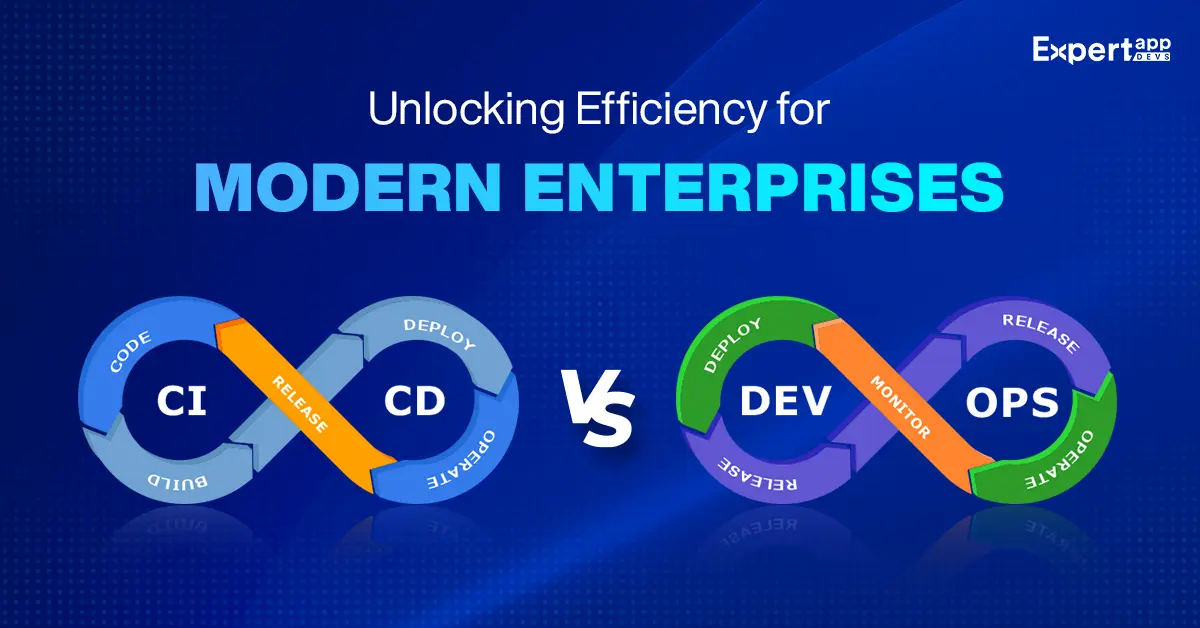CI/CD vs DevOps: The Key Difference of Implementation
Have you ever wondered why software projects fail even after using tools and technologies properly? It's because of choosing the wrong development methodology. This impacts your entire app development cycle, work quality, testing process, delivery, monitoring, and things goes on.
Research says that 70% of users simply stop using the app if they notice slow loading or crash and 29% of users just uninstall the app if it's not valuable or makes sense to them(browserstack).
All these problems are caused due to improper testing methods, lack of integration, wrong use of methodology, and more. CI/CD vs DevOps solve this problem by allowing teams to automate, integrate, and deploy the code changes easily.
If you are also experiencing delays in application delivery, testing, and overall collaboration, then read this article to understand the differences between CI CD vs DevOps, and how implementing it can benefit your app development.
Let's start first by reading the basic definition of CI/CD vs DevOps.
Understanding CI/CD vs DevOps
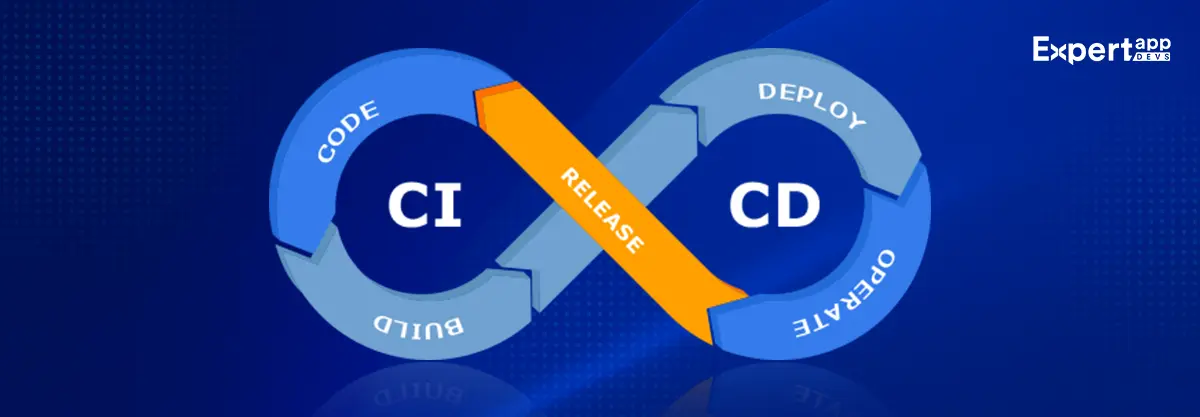
What is CI/CD?
CI/CD is a popular development practice followed by developers to deliver high-quality applications with minimal effort. Here the code is stored in the shared repository where the entire development team integrates, automates, and deploys the changes frequently.
Benefits of CI/CD in App Development

✅Faster Software Releases
CI/CD helps to automate and test every process one by one hence new features and new bug fixes are immediately delivered to users.
✅High-Quality Apps
Developers can thoroughly check each line of the code through suitable CI/CD tools hence this helps to catch bugs in the early phase and ensure high-quality code.
✅Better Collaboration Among The Team
As everyone in the team works on the shared repository, this boosts a transparent work culture and reduces the chances of loopholes because of continuous integration and collaboration.
✅Less Manual Work
Your developers can focus on other important tasks without worrying about human error and write better codes as the CI/CD pipeline handles everything with automation.
✅Reduced Cost
As the bugs are already identified before the situation gets worse, this helps to save bug-fixing costs in the future.
Challenges while Integrating CI/CD
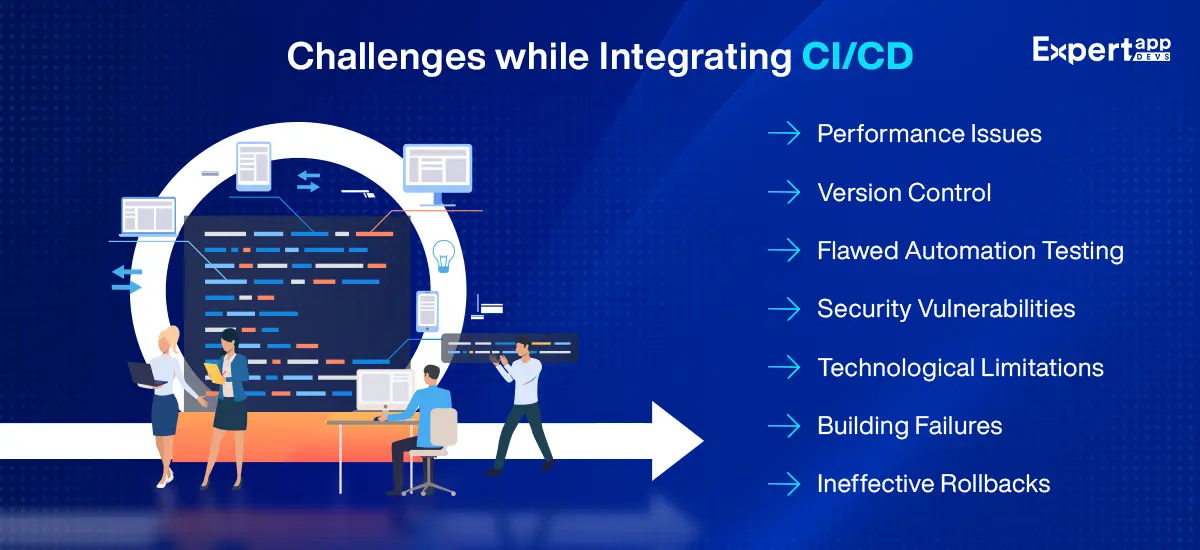
Every app development is unique and every day developers are facing unique challenges. Below are some of the challenges that you might face if you don't implement CI/CD properly.
✔Performance Issues
If the CI CD pipeline is not set up correctly using the right tools and infrastructure, this can lead to performance issues like slow page loading, unresponsive server errors, memory optimization issues, and more.
✔Version Control
It can be challenging when multiple developers are trying to update the code or process. When proper branching strategies and merges are not followed or done frequently by the team, the code becomes inconsistent and that leads to deployment issues and delays in the CI/CD pipeline.
✔Flawed Automation Testing
CI/CD systems mostly rely on automated testing, but bad queries or obsolete test cases can lead to false positives and negatives. When tests fail more or less randomly, teams spend time debugging. Ineffective test automation can delay deployments and lead to faulty codes.
✔Security Vulnerabilities
Developers are continuously pushing code updates and other sensitive information, this can lead to security vulnerabilities if you have not integrated security checks.
✔Technological Limitations
CI/CD tools are not compatible with every technology stack. Legacy systems and even cloud services have compatibility issues that slow down automation efforts.
✔Building Failures
Wrong configuration is one of the common reasons for build failure and it can disrupt the entire CI/CD pipeline process. This usually happens due to dependency issues, misconfigured environments, or broken code.
✔Ineffective Rollbacks
If the deployment is done in the wrong way, rolling back to a stable version can be time-consuming and cause downtime. This also affects your business continuity and user experience.
Examples of CI/CD
Suppose you are building a food delivery app so, below will be the ci cd pipeline process implementation.
- Start by building a shared repository on GitHub, or GitLab. Developers can collaborate and track changes here related to code and other updates.
- The developer starts writing and pushes the code into the repository. Let's say, you are making a food delivery app and want to test the scheduled delivery feature.
- Now implement Continuous Integration (CI). at this phase, your code is automated, tested, and checked for bugs. You can check the suggestions for bug fixes and work on it accordingly.
- Implement continuous deployment(CD). The app is automatically built and prepared for deployment. The new feature is deployed in a testing environment.
- If everything in the app goes well, the app is deployed on the Play Store or App Store. If an issue is found, the pipeline automatically rolls back to the last working version.
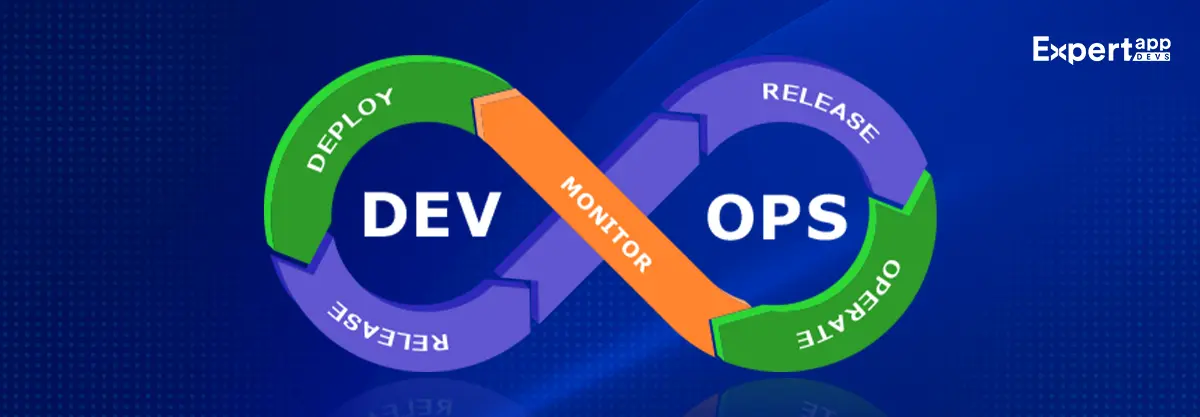
What is DevOps?
DevOps is a combination of the development of operations. This is the practice where developers and the operation team work together for better understanding and high-quality output.
DevOps culture makes the development cycle more efficient as here developers and operations discuss about the right tools, techniques, and other things to ensure the final product perfectly aligns with customer needs.
Benefits of DevOps Principles

✅Improved Software Quality
As every member of the organization participates in the project, it is easy to catch errors. Plus, continuous monitoring helps in identifying performance issues early, hence user expectations are fulfilled.
✅More Flexible
DevOps is more flexible than traditional methods because teams can respond quickly, whether it be adding new features, fixing issues, or scaling the application.
✅Continuous Improvement
As DevOps is a culture of learning and evolution, teams here review past deployments, gather feedback, and improve their processes. This continuous improvement cycle ensures better results, more efficient processes, and innovation.
✅Competitive Advantage
You can quickly launch your app with creative features and get fast feedback from your team and users. This speed provides a competitive advantage over companies that depend on slower, conventional development processes.
✅The Cultural Shift
It boosts the positive culture shift where developers and the operation team work on the same page to understand every ideology and side of the app.
Examples of DevOps
Research has found that 86% of companies have adopted the DevOps method to quickly launch their product. Do you know that famous companies like Amazon, Netflix, Adobe, and many more also use DevOps?
Let us understand DevOps culture with Netflix's example.
- Netflix uses a microservices architecture, in which it breaks its system into small, well-defined, independent services that can be scaled out easily — and it has millions of users streaming around the world.
- CI/CD allows developers to push updates regularly without service interruption. Their principles of chaos engineering test instances of failures in real-time, and make sure high availability with rapid recovery.
- Netflix relies on automated monitors and rollback processes to ensure seamless streaming when site traffic is high.
Hence by implementing the DevOps concept, Netflix has now become an industry leader and favorite platform among genZ, millennials, and users of all ages.
Challenges while Integrating DevOps
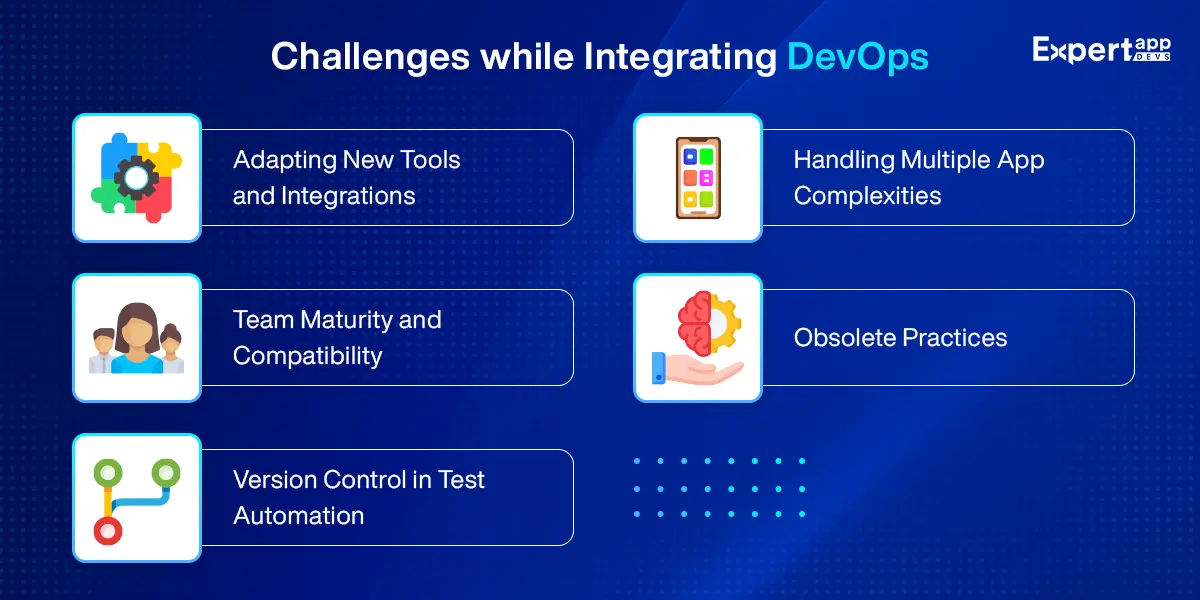
However, DevOps perfectly fulfills its goal of making the development cycle efficient but apart from this some non-technical factors like cultural barriers, communication gaps, improper processes, and much more can cause problems. Below are some of the challenges you must be aware of while using devops so you can solve them smartly.
✔Adapting New Tools And Integrations
It's obvious, that if you want to develop a successful app/software in today's time, developers must adapt to the using new tools and technologies. As DevOps culture is all about coordinating and working together for better results, this can cause a gap in the project when choosing the right tool, considering security and infrastructure aspects, and investing time in training the developers to use the tools in the right manner.
✔Handling Multiple App Complexities
If your app is bigger and more complex, it could possibly cause multiple complexities. You might need to make separate app environments for staging, testing, and deploying to identify the complexity.
✔Team Maturity And Compatibility
If you don't have mature and understanding software engineers on your team, this could disturb the flow of your app development cycle. Hence make sure developers in the team have the same mindset towards the goal and the same choice of tools, and technologies to avoid conflicts.
✔Obsolete Practices
Siloed teams who keep on working independently from DevOps teams can mess up the entire flow of the work. Especially, when using legacy tools, this could waste everyone’s efforts toward modernization, leading to poor communication and unfulfilled project goals.
✔Version Control In Test Automation
Even devops depend on a version to handle its process and components. it's important that all teams work on the same version. In case the scripts or tools are updated automatically, this could lead to compatibility issues in the DevOps pipeline
CI/CD vs DevOps: Key Differences
CI/CD vs DevOps both methods focus on improving processes and helping developers to deliver high-quality software, but they serve their purpose differently, let's understand how.

→ CI/CD is more focused on software development and delivery using automation with minimum risks. While DevOps focuses on the bigger picture where everyone in the team works with collaboration and responsibility to fulfill the app's goals.
→ CI/CD includes the following process: integration, testing, and delivery in sequence. The code is frequently integrated, and tested to catch the bugs at the early stage. On the other side, DevOps is not a process, it's a culture or environment where developers, the operation team, and the security team work with collaboration on planning, coding, testing, releasing, deploying, and monitoring.
→ CI/CD tools include Jenkins, Travis CI, and CircleCI for integration and for continuous deployment, developers use tools like Spinnaker, ArgoCD, and more. While the DevOps team uses tools that enhance collaboration for better results like containerization, docker, and more.
→ CI/CD teams have defined work and responsibilities such as developers handling the integration and testing code. While the operation department handles the deployment and monitoring part. While in DevOps, they don't have fixed or defined responsibilities because everyone works as a team and participates in every phase of development.
How To Choose The Right Approach From CI/CD vs DevOps For Your Business?
It's all about choosing the right approach. If you want to avoid deployment delays and inefficiencies in workflow and achieve a reliable and high-quality app, it's important to understand the situations when to use CI/CD vs DevOps.
When to Use CI/CD
✓Frequent code changes: If your teams push changes frequently, CI/CD allows automating tests and deployment, which can maintain stability.
✓When speed to market is a priority, CI/CD makes for faster and more efficient software delivery.
✓Minimizing Human Errors: Bugs caught in automated testing (of CI/CD) expend fewer resources than bugs found after production.
✓Scalable Apps: When your app increases with features, CI/CD helps you manage seamless, steady updates.
✓Agile Development: CI/CD is aligned with an agile workflow for incremental changes.
When to Implement DevOps
✓Collaboration Challenges: DevOps helps the teams communicate and work efficiently because development and operations teams work in silos.
✓Infrastructure as Code (IaC): If you have cloud-based or complex infrastructure, it automates provisioning and scaling.
✓Need for More Rapid Resolution of Issues: DevOps monitoring and automation enable you to spot and resolve issues quickly.
✓Ensuring security & compliance: A DevOps pipeline incorporates security checks to be compliant.
✓Large-scale app: It works best when you are dealing with large-scale applications and cloud environments.
Best Practices for Implementing CI/CD vs DevOps
CI/CD vs DevOps practices have been used for many years by the majority of big companies, but still, many developers struggle to use it in the right manner due to some or other issues. Follow the below best practices for successful app development, and keep the issues at bay.
Best Practices For Implementing CI/CD the Right Way

#1. Commit Early And Often
Frequent small commits keep the code stable and lower integration conflict so developers can easily find the issues on time to get them fixed quickly.
#2. Build Only Once
Inconsistencies arise from compiling code more than once in different environments. Write it once and use the same artifact for testing, staging, and production.
#3. Always Use Shared Pipelines
This reduces configuration errors and makes troubleshooting easier as everyone in the team is updated with what's going on during the development and testing phase.
#4. Secure Your Pipelines
Never store your credentials, API, and other sensitive data in the source code because there are chances that it could get leaked while updating and deploying. Implement security measures like access controls, encrypt sensitive data, and scan dependencies for vulnerabilities at every stage of the ci cd pipeline.
#5. Automate Tests
Don't depend on humans for testing. Automated tests will ensure that only stable, high-quality code makes it ahead in the pipeline, thus reducing production failures and downtime.
#6. Stick To Your Process
Sticking to the one-decided process avoids confusion and reduces the chances of errors in the software. Hence it's best to define coding standards, approval process, rollback strategy, and other things before working together.
Other than this, always use a clean test environment and use tools according to the priority. Keep monitoring the ci cd pipeline to monitor performance, identify bottlenecks, and avoid failures. Lastly, keep the whole team involved in the development, this will solve 70% of major issues and other confusions.
Best practices for DevOps the Right Way

#1. Have A Collaborative Work Culture
DevOps success depends completely on collaboration. Hence make sure developers, operation teams, and security teams work with complete understanding without a blaming mindset.
#2. Use Agile Method
It promotes flexibility and quick iterations that make it a perfect match for DevOps. This way, the team can easily respond to evolving needs, deliver frequent updates, and simplify the processes.
#3. Build Using The Right Tools
Using the latest and perfect tools aligning with needs helps to enhance software quality and speed up the delivery process.
#4. Implement Automation
Automations are only for repetitive and analysis tasks. Some things can be automated and can only be done manually. Hence avoid using automation where human logic is important.
#5. Use IaC(Infrastrucutre As Code)
IaC provides automated, repeatable deployments, leading to more stable environments. It simplifies scaling, avoids configuration drift, and minimizes downtime.
#6. Include Security From The Starting Stage
Why wait for things to get ruined? Implementing DevSecOps in the early stages of an application deployment is a way to detect vulnerabilities before deployment and reduce time and resources.
Conclusion
Hope this blog explains you difference between CI/CD vs DevOps, the benefits, and the best ways to implement it. Though both ci cd and DevOps have many similarities. You can create magical innovation when you combine both of these technologies.
Other than this, you must know when to use CI/CD and when to use DevOps because this will impact your entire development cycle and business ROI.
At Expert App Devs, we have served thousands of global clients with scalable and high–performing apps. With a focus on CI/CD pipelines, monitoring, and cloud-native technologies, our certified DevOps engineers follow industry-leading practices to deliver scalable apps. Schedule a consultation call if you want to learn more about our ci/cd services.
Frequently Asked Questions
Q1: How Is AI/ML Being Integrated Into CI/CD Pipelines?
☑ You can integrate AI/ML in the CI/CD pipeline by using it for automation, testing, anomaly detection, and predicting failures. AI-based tools can easily monitor code quality, and suggest fixes so that you can fix bugs quickly and deploy them faster.
☑ On the other side, there are many ML models that can also analyze deployment risks recommend rollbacks, and make your software release easy.
Q2: What Benefits Does AI/ML Bring To DevOps Practices?
☑ You can use AI/ML to improve automation, cut down downtime, and optimize performance in DevOps. It benefits the DevOps cycle in many ways due to smart monitoring, predictive analysis continuous monitoring, assessing code quality, and more.
Q3: How Can Enterprises Prepare For AI/ML Adoption In CI/CD vs DevOps?
☑ If you want to use AI/ML in CI/CD vs DevOps, do the following things:
- You must start by assessing your current CI/CD and DevOps maturity to identify AI/ML integration opportunities
- Train your teams to use more and more AI/ML-driven automation tools
- Choose scalable infrastructure and AI-powered analytics for more efficiency
- Use AI/ML in testing, deployment, and anomaly detection
Q4: What Is DevSecOps, And How Does It Differ From Traditional DevOps?
☑ DevSecOps focuses more on security at each step of the DevOps lifecycle. This allows to detection of threats at the starting stage and reduces risks.
☑ While in traditional DevOps, security is considered a secondary step late. It usually focuses on delivering software through automation and collaboration.
Q5: Why Is Security-Critical In CI/CD Pipelines?
☑ As ci cd works more on automation, the code is continuously pushed and updated through an automated pipeline hence it can be vulnerable to real-time threats. Even a single mistake or misconfiguration can lead to a breach, so security is a serious thing while working with the ci cd pipeline.
Q6: What Are Some Best Practices For Implementing DevSecOps?
☑ Below are some of the best practices for using DevSecOps.
- Use automated security checks in your CI/CD pipeline
- Follow the shift left security rule which means considering security in the early stage rather than fixing it afterward
- Run regular threat and vulnerability tests
- Role-based access to sensitive data
Q7: What Trends Are Shaping The Future Of App Development?
☑ There is no doubt, that automation is the new future in today's digital world. Other than this, there are many trends that shapes the app development beautifully. Some of them are:
- Low-Code/No-Code Development
- Edge Computing
- Blockchain powered by AI
- Hyper-personalization and many more
Q8: What Role Will Cloud Computing Play In The Future Of CI/CD And DevOps?
☑ Cloud computing will power flexible, scalable, and cost-efficient DevOps pipelines. Serverless architectures, multi-cloud strategies, and cloud automation driven by AI will make deployment easier, collaboration easier, and enable quicker software delivery to distributed workforces.
Q9: What Challenges Can Organizations Expect In The Future of App Development And IT Operations?
☑ Challenges can't be predicted because the technologies are continuously evolving. But there are some challenges that developers face right now. Many developers face challenges while managing complex cloud-native applications in terms of scalability, security, compliance, and skill gaps. Also keeping up with the regular updates gets tough.
 Jignen Pandya
Jignen Pandya
